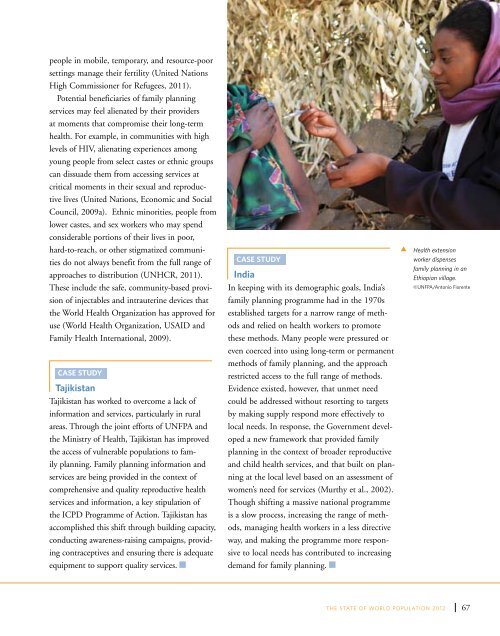State of World Population 2012 - Country Page List - UNFPA
State of World Population 2012 - Country Page List - UNFPA
State of World Population 2012 - Country Page List - UNFPA
You also want an ePaper? Increase the reach of your titles
YUMPU automatically turns print PDFs into web optimized ePapers that Google loves.
people in mobile, temporary, and resource-poor<br />
settings manage their fertility (United Nations<br />
High Commissioner for Refugees, 2011).<br />
Potential beneficiaries <strong>of</strong> family planning<br />
services may feel alienated by their providers<br />
at moments that compromise their long-term<br />
health. For example, in communities with high<br />
levels <strong>of</strong> HIV, alienating experiences among<br />
young people from select castes or ethnic groups<br />
can dissuade them from accessing services at<br />
critical moments in their sexual and reproductive<br />
lives (United Nations, Economic and Social<br />
Council, 2009a). Ethnic minorities, people from<br />
lower castes, and sex workers who may spend<br />
considerable portions <strong>of</strong> their lives in poor,<br />
hard-to-reach, or other stigmatized communities<br />
do not always benefit from the full range <strong>of</strong><br />
approaches to distribution (UNHCR, 2011).<br />
These include the safe, community-based provision<br />
<strong>of</strong> injectables and intrauterine devices that<br />
the <strong>World</strong> Health Organization has approved for<br />
use (<strong>World</strong> Health Organization, USAID and<br />
Family Health International, 2009).<br />
CASE STUDY<br />
Tajikistan<br />
Tajikistan has worked to overcome a lack <strong>of</strong><br />
information and services, particularly in rural<br />
areas. Through the joint efforts <strong>of</strong> <strong>UNFPA</strong> and<br />
the Ministry <strong>of</strong> Health, Tajikistan has improved<br />
the access <strong>of</strong> vulnerable populations to family<br />
planning. Family planning information and<br />
services are being provided in the context <strong>of</strong><br />
comprehensive and quality reproductive health<br />
services and information, a key stipulation <strong>of</strong><br />
the ICPD Programme <strong>of</strong> Action. Tajikistan has<br />
accomplished this shift through building capacity,<br />
conducting awareness-raising campaigns, providing<br />
contraceptives and ensuring there is adequate<br />
equipment to support quality services.<br />
CASE STUDY<br />
India<br />
In keeping with its demographic goals, India’s<br />
family planning programme had in the 1970s<br />
established targets for a narrow range <strong>of</strong> methods<br />
and relied on health workers to promote<br />
these methods. Many people were pressured or<br />
even coerced into using long-term or permanent<br />
methods <strong>of</strong> family planning, and the approach<br />
restricted access to the full range <strong>of</strong> methods.<br />
Evidence existed, however, that unmet need<br />
could be addressed without resorting to targets<br />
by making supply respond more effectively to<br />
local needs. In response, the Government developed<br />
a new framework that provided family<br />
planning in the context <strong>of</strong> broader reproductive<br />
and child health services, and that built on planning<br />
at the local level based on an assessment <strong>of</strong><br />
women’s need for services (Murthy et al., 2002).<br />
Though shifting a massive national programme<br />
is a slow process, increasing the range <strong>of</strong> methods,<br />
managing health workers in a less directive<br />
way, and making the programme more responsive<br />
to local needs has contributed to increasing<br />
demand for family planning.<br />
t<br />
Health extension<br />
worker dispenses<br />
family planning in an<br />
Ethiopian village.<br />
©<strong>UNFPA</strong>/Antonio Fiorente<br />
THE STATE OF WORLD POPULATION <strong>2012</strong><br />
67
















